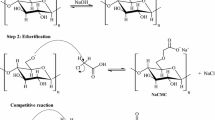Abstract
This paper concerns the rheological behavior of carboxymethylcelulloses(CMC) derived after one and two successive steps from different non-woodbleached cellulose pulps. CMC rheological characterization was achieved in0.1M NaCl solution, as a function of polymer concentration. Theevidence of a critical concentration (C* < 1 g/L) is discussedfromsteady shear and dynamic experiments. Rheological properties of the CMC werefound to depend on the cellulose source reactivity and on their degree ofsubstitution (DS). Higher molecular weight of initial cellulose was accompaniedby higher apparent intrinsic viscosity of the CMC produced. Depending on theCMCconcentration and on the degree of etherification, the system behaves as asolution or as a gel. In the case of abaca CMC sample, it is shown that afteronly one step of chemical modification and above a polymer concentration of20 g/L, the system behaves as a gel. The gel behavior was studied asafunction of temperature. In the temperature range from 25 to 45°C, the rheological behavior was found to remain almostconstant due to the existence of dispersed swollen aggregates. This unusualcharacteristic represents an advantage for applications such as oil recovery inthe petroleum industry, where viscosity of the recovered fluid should not diminishwith temperature.
Similar content being viewed by others
References
Barba C., Montané D., Rinaudo M. and Farriol X. 2002. Synthesis and characterization of carboxymethylcelluloses (CMC) from non-wood fibers I. Accessibility of cellulose fibers and CMC synthesis. Cellulose 9: 319–326.
Bartdorf J.B. and Rossman J.M. 1973. Sodium carboxymethyl cellulose. In: Whistler L.R. (ed.), Industrial Gums. 2nd edn. Academic Press, New York, pp. 695–729.
Bouldin M., Kulicke W.M. and Kehler H. 1988. Prediction of the non-Newtonian viscosity and shear stability of polymer solutions. Colloid Polym. Sci. 266: 793–805.
Cescutti P., Paoletti S., Navarini L. and Flaibani A. 1993. Solution properties of the capsular polysaccharide produced by Klebsiella pneumonide SK1. Int. J. Biol. Macromol. 15: 201–207.
Cowman M.K., Hoefling J.M., Matsuodka S. and Balazs E. 2002.Temperature effect on the dynamic rheological characteristics of hyaluronan, hylan A and Synvisc. In: Kennedy J.K., Phillips G.O. and Williams P.A. (eds), Hyaluronan. Proceedings of an international meeting, September 2000, North East Wales Institute, Wrexham, UK. Woodhead Publishing, Cambridge, UK.
Dyre J., Hvidt S. and Kramer O. 1993. Towards phenomenological definition of the term "gel". Polymer Gels Networks 1: 5–17.
Greenway T.M. 1994. Water soluble derivatives and their commercial use. In: Gilbert D.R. (ed.), Cellulosic Polymers. Honser Publishers, New York, pp. 173–188.
Grigescu G. and Kulicke W.M. 2000. Prediction of viscoelastic properties and shear stability of polymers in solution. Adv. Polym. Sci. 152: 1–45.
Kulicke W.M., Kull A.H., Kull W. and Thielking H. 1996. Characterization of aqueous carboxymethylcellulose solutions in terms of their molecular structure and its influence on rheological behaviour. Polymer 37: 2723–2731.
Kurata M. and Tsunashima Y. 1989. In: Brandrup J. and Immergut E.H. (eds), Polymer Handbook, 3rd edn. Wiley Interscience, New York, pp. VII/1-VII/60.
Milas M., Rinaudo M. and Tinland B. 1985. The viscosity dependence on concentration, molecular weight and shear rate of xanthan solutions. Polym. Bull. 14: 157–164.
Milas M., Rinaudo M., Knipper M. and Schuppiser J.L. 1990. Flow and viscoelastic properties of xanthan gum solutions. Macro-molecules 23: 2506–2511.
Morris E.R., Cutler A.N., Ross-Murphy S.B. and Rees D.A. 1981.Concentration and shear rate dependence of viscosity in random coil polysaccharide solutions. Carbohydr. Polym. 1: 5–21.
Rinaudo M. 1990. Physicochemical properties of polysaccharides in relation to their molecular structure. In: Glasser W.G. and Hatakeyama H. (eds), Viscoelasticity of Biomaterials. ASC Symposium Series No. 489. American Chemical Society, Washington, DC, pp. 24–37.
Rinaudo M. and Hudry-Clergeon G. 1967. Etude des carboxyméth-ylcelluloses à degré de substitution variable. I. Préparation et caractérisation des produits. J. Chim. Phys. (Paris) 64: 1746–1752.
Rinaudo M., Lowys M.P. and Desbrières J. 2000. Characterization and properties of cationic cellulosic fibres. Polymer 41: 607–613.
Author information
Authors and Affiliations
Rights and permissions
About this article
Cite this article
Barba, C., Montané, D., Farriol, X. et al. Synthesis and characterization of carboxymethylcelluloses from non-wood pulps II. Rheological behavior of CMC in aqueous solution. Cellulose 9, 327–335 (2002). https://doi.org/10.1023/A:1021136626028
Issue Date:
DOI: https://doi.org/10.1023/A:1021136626028



